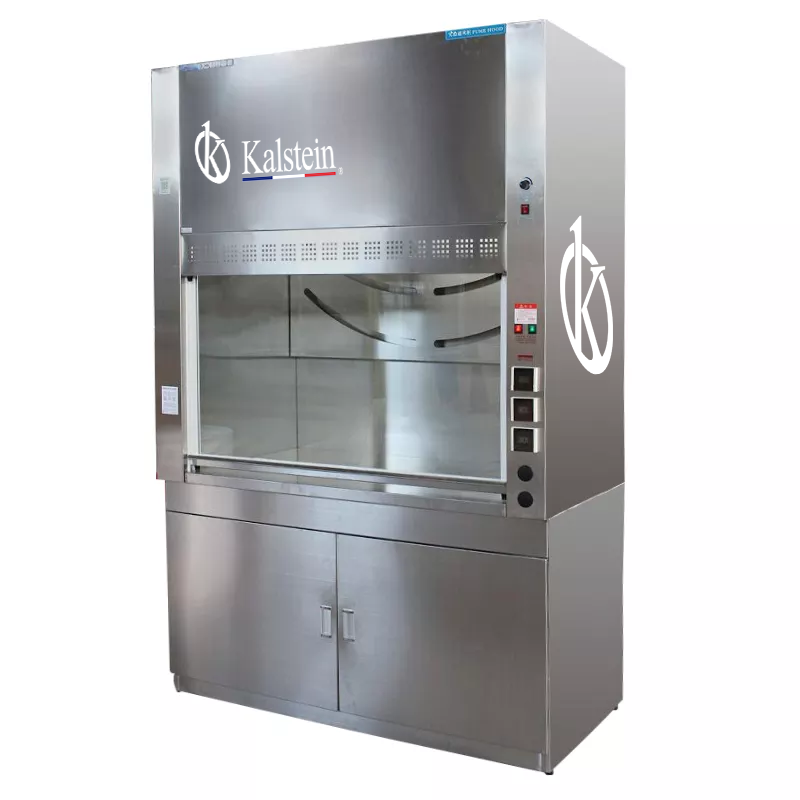A gas extraction hood is local ventilation equipment designed to limit user exposure to hazardous or noxious substances such as gases, fumes, vapors or dust. These laboratory equipment is equipped with protection against chemical spills, leak reactions and fires, acting as a physical barrier.
It is a device that arises from the need to control dangerous or irritating substances that are usually generated in the air or released within the local ventilation device itself. There are currently two main types of gas extraction hoods : duct hoods and recirculation hoods. The principle of operation for both is the same: the air is sucked from the front (open) of the box and, after passing through the filter and the exhaust motor, is ejected out of the building to a safe place. Outside air enters the room again to compensate for the pressure.
Structure and operation of a gas extraction campaign
A gas extraction hood has a box-shaped structure with a moving window. Tests and experiments are carried out within the hood which is constantly and safely ventilated, usually by fans and ducts. The chemical vapors generated by the various procedures are extracted and diluted many times in the atmosphere, making them harmless to human health. If environmental concerns exist, a treated extraction system can be installed, to remove most of the vapors from the external air stream.
The hood operates by maintaining negative air pressures inside the cabin, thus preventing any air particle from escaping out. The speed at which air enters the hood is very important to ensure the safety and effective operation of the equipment, as this is how the protective barrier is generated that will not let any of the contaminated air leave the interior. High speeds can generate turbulence that will allow the air inside to leave, but low speeds may not be enough containment, so there must be the right balance, recommending a front flow speed between 0.3m/s (60 feet per minute) and 0.5m/s (100 feet per minute), however, it is important to review the applicable safety regulations in your location.
Types of gas extraction hoods, according to their use
- Table hoods, for general use.
- Duct-free hoods: Characterized by the use of active carbon filtration to absorb chemical vapors and fumes. These hoods recirculate the air in the laboratory, currently one of the most used because of energy saving and being environmentally friendly.
- Perchloric acid hoods : Perchloric acid is a type of acid that reacts violently with organic materials, so these hoods need to have a washing system in order to prevent perchlorate residues. The inner linings are made of acid-resistant materials such as stainless steel and the corners are rounded for easy cleaning. All procedures using this acid must be carried out within such a campaign to avoid dangerous reactions when coming into contact with other substances.
- Radioisotope hoods : Used to protect users from radioactive material. It has a special base to support the cabin made of lead. The interior is designed in stainless steel and rounded corners.
- Acid digestion hoods: They have special coatings made of acid-resistant materials such as non-plasticized PVC, although for acid digestion applications that require high temperatures it would be advisable to use materials such as PVDF. The front panel can be made of polycarbonate to resist the influence of hydrofluoric acid.
What does Kalstein offer you?
Kalstein is a manufacturer of medical and laboratory equipment of the highest quality and the best technology at the best PRICES in the market, so you can make your PURCHASE confidently with us, knowing that you have the service and advice of a company specialized in the field and committed to provide you with safe, economical and effective options to perform your functions in the right way. HERE
- The extractor hood is used to protect the laboratory environment and operator during general chemical applications. It actively protects the operator from inhaling toxic fumes and dramatically reduces the risk of fire and explosion. By installing a suitable filter, you can also protect the environment.
- With memory function in case of power failure.
- Operators are available to walk towards the extraction hoods to operate if necessary.
- Exhaust system for large rooms, suitable for large instruments and laboratory equipment.
For more information we invite you to take a look HERE


